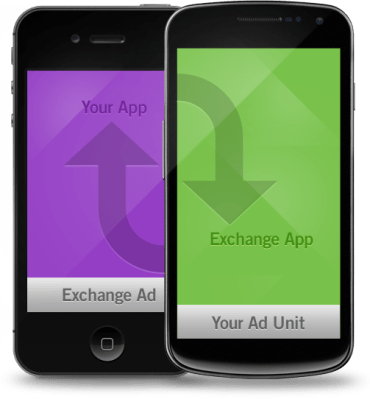Tap for Tap, a Victoria, B.C.-based startup that launched back in April, is already launching a significant shift to its business model called The Tap Exchange, just over half a year into its existence, based on feedback received from its initial crop of developers. Much like web rings of the early days of the internet, Tap for Tap hopes to help developers help each other by swapping unused ad inventory to promote downloads, but rather than basing things on the questionably valuable metric of impressions and offering only one method of advertising as it did originally, it now uses taps as the basis for earning credits, and offers three different ad formats to choose from.
The nice thing about Tap for Tap’s solution is that it’s an ad network that startups can use to promote growth, rather than to generate a revenue stream at a stage where their audience might not be mature enough to actually pull in significant paydays. Small fish can help grow with other small fish on a straightforward ad-trading basis, earning credits for generating taps to other content via either banner ads, interstitials or an app wall, which lives behind a button in a participating app. The options help developers pick an ad solution that works best with their existing app design, and there’s an exchange rate that helps developers trade more credits for better placement in more high-performing markets, including different app categories and geographic locations.
“We basically target and optimize on behalf of developers to get their tap-through rates up,” Ryan Gerhardt, Tap for Tap VP of Business Development explained in an interview. Co-founder Eric Dyck offered a little more detail about how exactly it’s working without any modifications or value-add features in play. “We’re going to value those click-throughs based on where they came from,” he said. “So a click from the U.S. would be worth a certain amount, and a click from Azerbaijan would be worth less. We’re going to try to give you the same mix of traffic that you yourself give at the base level, before you target anything.”
The monetization strategy behind Tap for Tap, which used to seek to pair small ads with paid ones from larger advertisers in a two-ad banner block, now shifts with the new model. Mostly, it’ll take the form of having advertisers who can afford it pay for premium placement, while still allowing developers to earn better placement and positioning via the exchange if they don’t have massive marketing budgets. Once the exchange is set up and running, Dyck says the company plans on adding a monetization layer that’s essentially “a traditional ad network on top” of the exchange itself.
Other ad firms are still competition for Tap for Tap, but there’s one challenge that may loom above all others. Apple recently shifted its rules to forbid the presence of apps that mimic or replicate the functionality of the App Store, which could be interpreted as disallowing things like the app wall Tap for Tap offers as an ad format option. Dyck and Gerhardt don’t think they’ll run afoul of Apple with Tap for Tap’s model, however, since the apps it appears in aren’t trying to be app storefronts, and are merely linking back to the App Store, not providing direct purchase capabilities.
As an ad player, Tap for Tap has already attracted around 5,000 developers to its network, and is averaging between 5 and 10 million impressions and around 100,000 taps per day. The startup now hopes to jumpstart its fortunes with its new, more engagement-focused business model which it believes will benefit mobile developers and advertisers alike.
